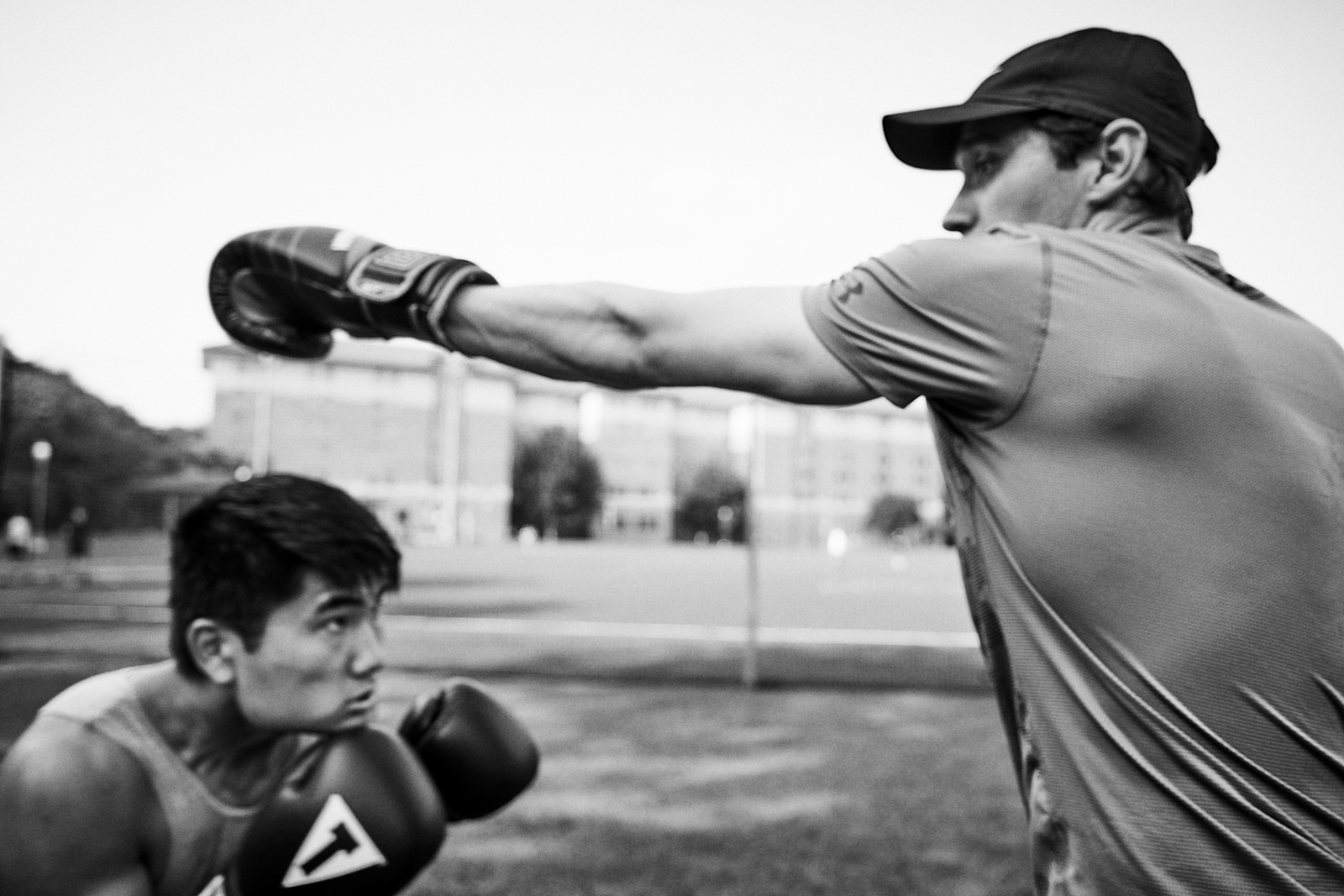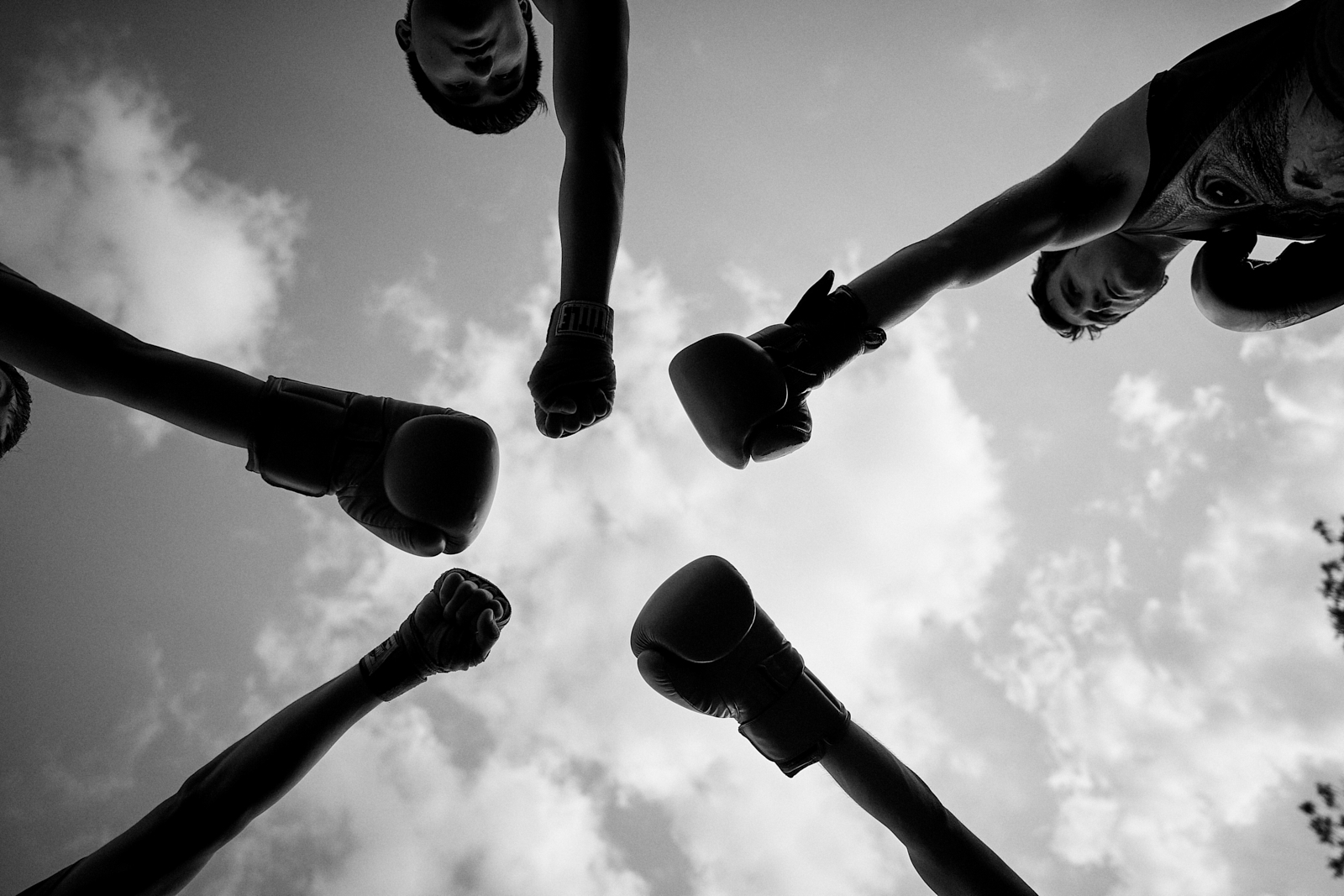Wielding the Golden Gloves

It’s the pugilist’s dilemma, inherent to the sport. In the ring, it’s a calculated, feinting dance, but an indisputable fistfight nonetheless, and when knuckles fly, despite protective equipment and short rounds, sometimes people get hurt. Boxing has a long history of death and traumatic brain injuries.
That’s why the UT Boxing Club is adamant about its no-sparring rule on campus, keeping meetings strictly fitness and technique-oriented, with more competitive training conducted at an off-campus gym. It’s also one of the reasons why the Longhorn Boxers remain a club rather than a recreational sport, otherwise known as a Sponsored Student Organization (SSO).

President Nathan Smith says the club has tried several times to become a rec sport, but they keep getting rejected because of the stigma of boxing causing concussions. “And like, sure, but we don’t practice like that,” he says. “We don’t hit each other during practice. It’s not conducive
to a good learning environment if everyone’s just getting punched. We never do that. We never have. No one’s ever gotten a concussion on-campus boxing.” During those fitness and technique-oriented practices on campus, Smith and other club leaders take members through high intensity interval training-style movements like you’d encounter in a fitness boxing class at a strip mall gym or in a Peloton program—jump roping, jogging in place, mountain climbers, jump squats, learning a fighting stance, and how to properly jab by making a fist and extending it so your knuckles point up and palms face down.
UT’s original boxing organization was founded in 1930 and was initially known as the Golden Gloves Club. The fighters regularly drew crowds that packed Gregory Gymnasium for their “Fite Night” tournaments. The only reason UT didn’t compete in a conference championship at that time, according to the Cactus, was because there were no other schools in the Southwest Conference participating in intercollegiate boxing.
COVID-19 hampered recruiting efforts and temporarily fractured the group’s sense of cohesion. But through it all, former president Alejandra Gutiérrez, BS ’21, showed up on Zoom every week, even if just one other person logged on, to build connections, explain the sport to newbies, teach a few basic punches, and let people know the club wasn’t going anywhere. She and other members recorded and posted training videos on the club’s Facebook page so folks could keep working on boxing skills, despite the long months of isolation and virtual classes, virtual everything.
Under Gutiérrez’s leadership, UT Boxing rose to perhaps its greatest contemporary prominence. Before she graduated, she encouraged the club to begin competing at collegiate championships. In the ring, Gutiérrez was thrilled by the lack of boundaries she felt, the freedom to tap into her aggression, a sharp contrast to her typically reserved, rule-conscious, and often anxious personality. She started boxing when she was in high school, but stopped for a time because her parents disapproved. She can’t pinpoint what exactly drew her to the sport; it’s just something about the intensity and its contrast with her self-described shy nature that gives her a thrill and boosts her confidence. Throughout her three years with the club, she was the sole woman member who remained for more than a year. Women’s boxing only became an Olympic sport in 2012, and the first national championship for women’s collegiate boxing came about one year later.
In many ways, Gutiérrez was breaking new ground. She formed meaningful friendships within the club, but also acknowledges that it’s not the most inviting environment for women. “I think it was just the overall sense of like, we don’t belong here,” she says. There are a few consistently in the club now who are interested in taking on leadership roles. “That’s really good because back then it was only me … It’s still really difficult to get girls to stay, but it’s going. Eventually, it will get there.”
As an SSO, the club wouldn’t have to constantly scramble to find a new practice space. They’d be provided with a guaranteed space on campus to meet twice a week, and maybe even a dedicated coach or mentors. A few members work with Coach Robert Clemente at Buffalo Boxing Club and Randy Palmer, a professional kickboxer and owner of South Austin Gym, but both coaches already have many other athletes under their tutelage. They’d also be able to attract new members by being listed on the university’s RecSports website and getting to participate in official recruiting events. As it is, the club’s HornsLink page, which links to the Longhorn Boxing Facebook page, is toward the bottom of the first page of search results on Google; a little intentionality is required to find them.
With more community events and a stronger social media presence, Smith says, “We’ll make it feel like an official club that people can be a part of and then hopefully, UT starts to recognize us more.”

Most of the current Longhorn Boxers are new to the sport. They’re just learning technique and how to do the basics—proper stance, footwork, and punching form. Smith grew up watching matches on TV, and has become so passionate about boxing since joining the club, he plans to compete as an amateur after graduating. He loves the mental side of the sport, which he likens to playing chess, and feels it’s an approachable, inclusive activity that anyone can excel at. But he’s cautious where new members are concerned; he would never pressure anyone to compete before they’re ready. But when he graduates, what new shape will the club take?
There’s Daniel, a grad student who’s a bit older than the other club members, which Smith feels gives their club a seriousness. Payton, a freshman girl who’s dedicated to learning everything she can about the sport; she’s a regular fixture at South Austin Gym. And there’s Andres, who moved to the U.S. from Mexico when he was just a kid and already competes in amateur fights in the 115-pound super flyweight class.
They’ll keep applying to become a recreational sport, and maybe someday they’ll be approved as the first ever boxing team at The University of Texas. That would make them proud. But in the meantime, they’ll keep working on technique—hooks, jabs, uppercuts, and all their combinations—maintaining fitness, and staying ready.
CREDITS: Matt Wright-Steel





